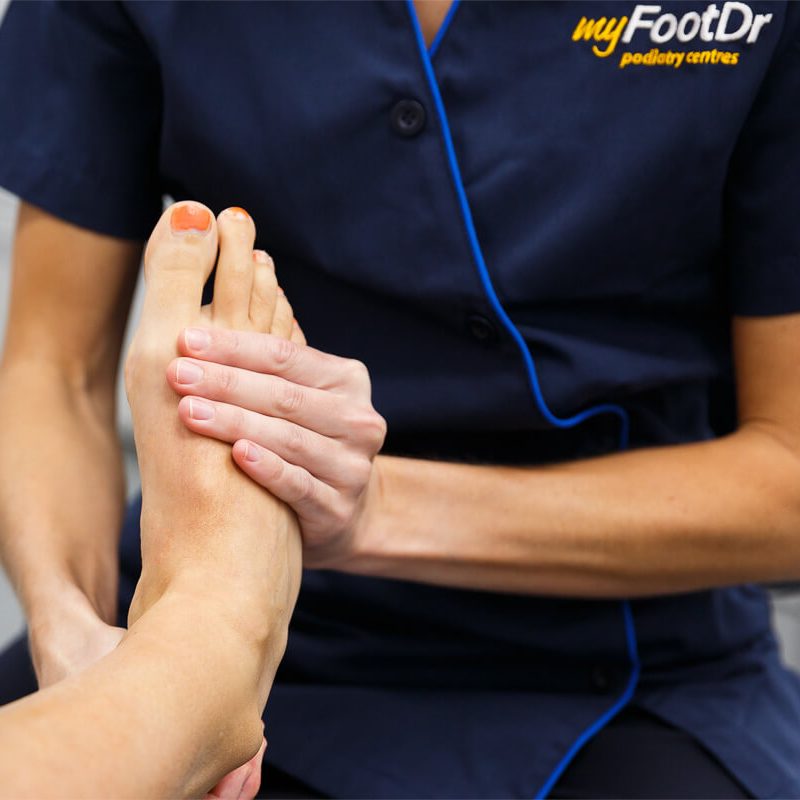Prevent Bunions From Getting Worse
Bunions are one of the most common foot disorders that affect people.
Even though bunions are a common foot deformity, the most common seen by podiatrists, many misconceptions are associated with this deformity. Many people may unnecessarily suffer the pain of bunions for years before seeking care management. Failing to manage bunions early, allows for them to progress and develop further, only to create additional pathophysiology that otherwise could have been prevented.
At My FootDr Singapore, we aim to see patients with healthy feet preventing the early development of bunions.
What is a Bunion
A bunion (also referred to as ‘hallux valgus’ or ‘hallux abducto valgus’) is a bump on the side of the big toe joint. It develops when your big toe starts to angle towards your second toe. A bunion is a lot more involved than just that. It actually reflects changes to the bony framework and the joint integrity of the big toe joint (the first metatarso-phalangeal joint). This causes the hallux (the big toe) deviates towards the lesser toes and the first metatarsal (the bone that the big toe connects to) moves towards the midline of the body.

A Progressive Disorder
Bunions are a progressive disorder resulting in osteo-arthritis of the big toe joint. They begin with a slight leaning of the big toe, gradually changing the angle of the bones over many years and slowly producing the characteristic bump, which becomes increasingly prominent. Eventually pain and discomfort set in. The skin over the lump can become red and blistered and a fluid-filled sac (called a bursa) may develop under the skin on the side of the joint. This causes immense pain as it becomes inflamed. It is known as a bursitis.
Bunion affecting foot biomechanics
The foot deformity can also make it harder to find shoes that fit properly. A bunion may force a person to buy larger size footwear to accommodate the extra width the bunion creates. When the deformity becomes severe enough, the foot can hurt not only at that area, but at different places. Bunion interrupts the normal biomechanics of the foot. It changes the normal centre of pressure pathways through the feet and puts extra pressure on structures that are not meant to undergo such large increases in pressure.
How We Help With Bunions
If you think you are developing bunions, the best course of action is to visit a podiatrist to prevent further development. Unfortunately, once the deformity occurs there is no way to reduce the size of the lump without surgery. Therefore, early detection is important to avoid future pain and complications.
Like all conditions, it is important to identify what is causing the abnormality and how far the condition has developed. A podiatrist will use patient history to determine risk factors and possible causes.
If you have a bunion, you may have:
- pain or stiffness of the big toe joint
- swelling of the big toe joint
- difficulty walking
- difficulty finding shoes that fit
- pain under the base of the 2nd and 3rd toe joints
If you have any of these symptoms, you should see your podiatrist.
Assessment
A biomechanical assessment will determine whether biomechanical foot abnormalities such as excessive pronation are causing the development of foot deformities.
Prescription
If a patient presents with excessive pronation, custom orthotics can be prescribed to preserve the movement and condition of the big toe joint and prevent further complications. Custom orthotics also help improve posture and stabilise the big toe joint.
Surgical correction
Surgical correction is an option, but should only be considered after other podiatry care options have been explored to prevent the onset of the deformity.
Learn more about the causes, symptoms and care management here.



